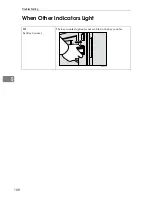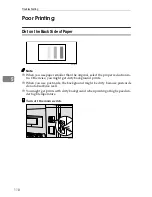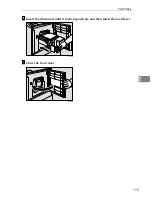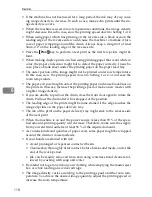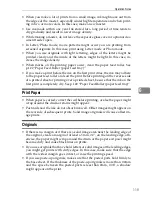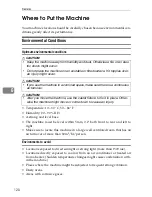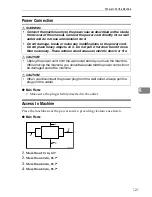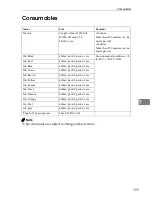
Operation Notes
119
6
• When you make a lot of prints from a small image, ink might ooze out from
the edges of the master, especially under high temperature and when print-
ing in two or more colors. In this case, make a new master.
• Use ink made within one year. Ink stored for a long period of time tends to
dry gradually and result in lower image density.
• While making a master, do not leave the exposure glass cover or optional doc-
ument feeder open.
• In Letter/Photo mode, moire patterns might occur you are printing from
screened originals. In this case, print using Letter mode or Photo mode.
• When you use originals with light lettering, edges of the letters might be
printed clearly and the inside of the letters might be light. In this case, in-
crease the image density.
• When marks on the printing paper occur, clean the paper feed roller. See
p.122 “Paper Feed Roller (paper feed tray)”.
• If you make a print before the ink on the first print dries, the ink may adhere
to the paper feed roller and soil the print. Before printing on the reverse side
of a printed sheet or printing over a printed sheet, be sure that the ink on the
first print is completely dry. See p.122 “Paper Feed Roller (paper feed tray)”.
Print Paper
• When paper is curled, correct the curl before printing, or else the paper might
wrap around the drum or stains might appear.
• Postcards and the like do not absorb ink well. Offset images might appear on
the rear side of subsequent prints. Solid image originals will cause offset im-
age prints.
Originals
• If there is no margin or if there is a solid image area near the leading edge of
the original, create a margin of at least a 5mm, 0.2", on the leading edge; oth-
erwise, the paper might wrap around the drum or the paper exit pawl might
become dirty and cause black lines on prints.
• If you use originals that have bold letters or solid images at the leading edges,
you might get prints with dirty edges. In this case, make sure that the edge
with the widest margin goes in first, or raise the printing speed.
• If you use paste-up originals, make sure that the pasted parts hold firmly to
the base sheet. If the thickness of the paste-up originals is more than 0.2mm
and the space between the pasted parts is less than 2mm, 0.08", a shadow
might appear on the print.
Содержание 3560DNP
Страница 2: ...Type for CP6244 LDD145 JP4500 3560DNP Printed in Japan EN USA C249 8697 ...
Страница 26: ...8 ...
Страница 33: ...After Printing 15 1 G G G G Close the paper delivery tray H H H H Turn off the main switch ZBHH051E ZFRH100E ...
Страница 78: ...Operation 60 1 ...
Страница 88: ...Optional Functions 70 2 ...
Страница 134: ...Troubleshooting 116 5 ...




